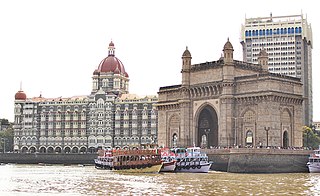
Vada pav, alternatively spelt wada pao, is a vegetarian fast food dish native to the Indian state of Maharashtra. The dish consists of a deep fried potato dumpling placed inside a bread bun (pav) sliced almost in half through the middle. It is generally accompanied with one or more chutneys and a green chili pepper. Although it originated as an affordable street food in Mumbai, it is now served in food stalls and restaurants across India. It is also called Bombay burger in keeping with its origins and its resemblance in physical form to a burger.

Bhelpuri is a savoury snack originally from India, and is also a type of chaat. It is made of puffed rice, vegetables and a tangy tamarind sauce, and has a crunchy texture.

Bombay mix or chanachur is an Indian snack mix (namkeen) which consists of a variable mixture of spicy dried ingredients, such as fried lentils, peanuts, chickpeas, chickpea flour ganthiya, corn, vegetable oil, puffed rice, fried onion and curry leaves. This is all flavored with salt and a blend of spices that may include coriander and mustard seeds.

Pani puri is a deep-fried breaded sphere filled with potato, onion, or chickpea. It is a common street food in the Indian subcontinent. It is often spiced with tamarind chutney, chili powder, or chaat masala. A Bengali variant, fuchka, uses spiced mashed potatoes as the filling.

A hawker is a vendor of merchandise that can be easily transported; the term is roughly synonymous with costermonger or peddler. In most places where the term is used, a hawker sells inexpensive goods, handicrafts, or food items. Whether stationary or mobile, hawkers often advertise by loud street cries or chants, and conduct banter with customers, to attract attention and enhance sales.

A resident of Mumbai is called a Mumbaikar. People prefer to stay close to a railway station for easy access to the metropolis. Many city-dwellers lead a fast-paced life with very little time for other activities owing to a significant amount of time spent on daily commuting.

Street food refers to food or drinks sold by a hawker or vendor on a street or at other public places, such as markets, fairs, and parks. It is often sold from a portable food booth, food cart, or food truck and is meant for immediate consumption. Some street foods are regional, but many have spread beyond their regions of origin. Most street foods are classified as both finger food and fast food and are typically cheaper than restaurant meals. The types of street food vary between regions and cultures in different countries around the world. According to a 2007 study from the Food and Agriculture Organization, 2.5 billion people eat street food every day. While some cultures consider it to be rude to walk on the street while eating, a majority of middle- to high-income consumers rely on the quick access and cheap service of street food for daily nutrition and job opportunities, especially in developing countries.

Chaat, or chāt is a family of savoury snacks that originated in India, typically served as an hors d'oeuvre or at roadside tracks from stalls or food carts across South Asia in India, Pakistan, Nepal and Bangladesh. With its origins in Uttar Pradesh, India, chaat has become immensely popular in the rest of South Asia.

Puri, also poori, is a type of deep-fried bread, made from unleavened whole-wheat flour, originated from the Indian subcontinent.

Pav bhaji is a street food dish from India consisting of a thick vegetable curry (bhaji) served with a soft bread roll (pav). It originated in the city of Mumbai.
Maharashtrian or Marathicuisine is the cuisine of the Marathi people from the Indian state of Maharashtra. It has distinctive attributes, while sharing much with other Indian cuisines. Traditionally, Maharashtrians have considered their food to be more austere than others.

Dahi puri is an Indian snack food which is especially popular in the state of Maharashtra. The dish is a type of chaat and originates from the city of Mumbai. It is served with mini-puri shells (golgappa), which are also used for the dish pani puri. Dahi puri and pani puri chaats are often sold by the same vendor.

Bun kebab or anda shami is a sandwich that originated in Pakistan, but is now popular all throughout the Indian subcontinent. Bun kebabs are a signature in Pakistani metro cities like Karachi and Lahore, but they can be found all over Pakistan. Bun Kebab vendors are scattered all across Karachi, vendors on Burns Road being particularly famous, and imitated by frozen bun kebabs sold in South Asian supermarkets across the world. In India, it is eaten as a regular street food, specifically, in the Indian cities of Bhopal, Lucknow, and Hyderabad; it is especially popular with Indian Muslims, the dish is eaten late-night during Ramadan. Bun kebabs are usually sold from roadside stalls, side street vendors, and fast food restaurants. They are also commonly known as anday wala burger. A ‘fried’ version of the bun kebab is popular in Lahore, known as ‘bun plaster’ due to copious amounts of butter and super tender or paste-like kebab mixture used in it. Bun kebabs are usually eaten as a main course or snack.

Regional street food is street food that has commonalities within a region or culture.

Sev puri is an Indian snack and a type of chaat. It is a speciality that originates from Mumbai, Maharashtra, India. In Pune and Mumbai, sev puri is strongly associated with street food, but is also served at upscale locations. Recently, supermarkets have started stocking ready-to-eat packets of sev puri and similar snacks like bhelpuri.

Jumboking is an Indian vegetarian burger quick service restaurant chain. Established on 23rd August 2001 by Dheeraj Gupta, Founder and MD of Jumboking and Reeta Gupta, the Co-founder, the company got inspired by the fast food business model of McDonald's and Burger King. The chain has more than 145 outlets in major Indian cities such as Mumbai, Navi Mumbai, Thane, Delhi, Hyderabad and Pune. The company has delivery tie-ups with Swiggy and Zomato to service out-of-store orders.

Street food, as in other areas of India, are popular in Chennai, despite the common belief in India that street food is unhealthy. The idly sambhar is a popular dish, which is served as breakfast or dinner. Apart from regular South Indian street food, the city's streets are also filled with several North Indian street food outlets, most of them established by North Indian migrants themselves. Gujarati and Burmese are also available. Street food in Chennai is so popular that a game had developed based on the TV show The Amazing Race where contestants have to follow clues to street-food spots in the city.

Masala puri, or Masalpuri, is an Indian snack which is especially popular in the southern state of Karnataka. A form of chaat, the dish originated in the Indian state of Karnataka and has now become famous in the entire Indian subcontinent. Typically spicy, the dish can also be made sweet based on the requirement.

Street food of Kolkata is the food sold by hawkers and street vendors from portable market stalls in the streets of Kolkata, India. It is one of the major characteristics of the city, which makes Kolkata the "City of Joy". Kolkata's street foods include Indian street food as well as Chinese, Mughlai, British, and even European foods.























